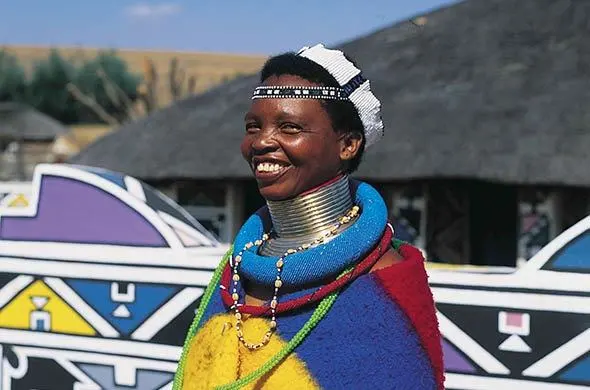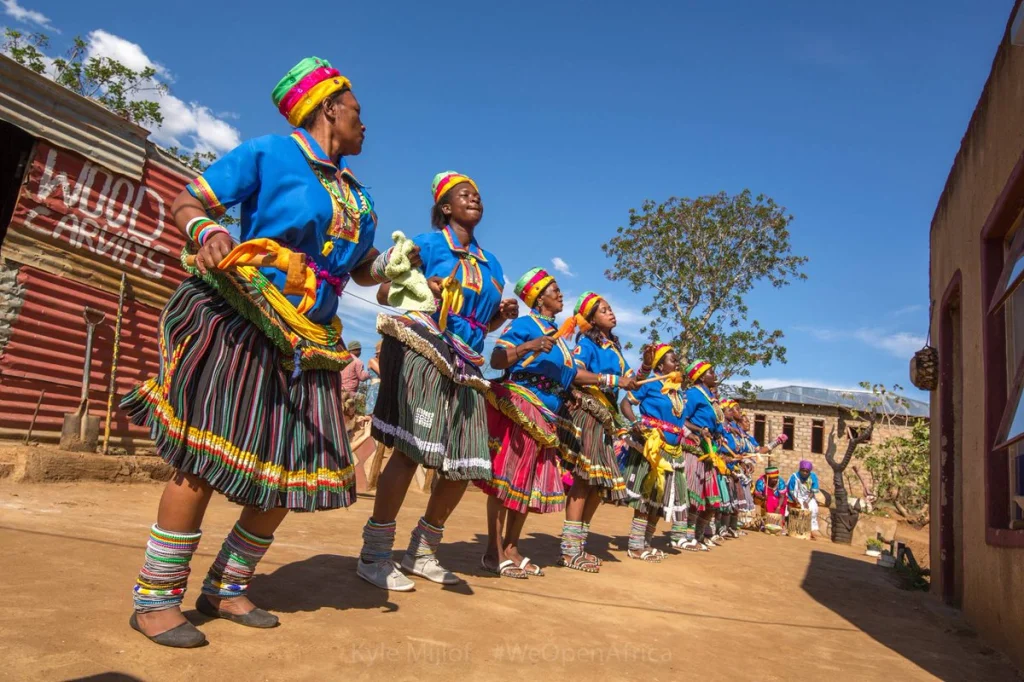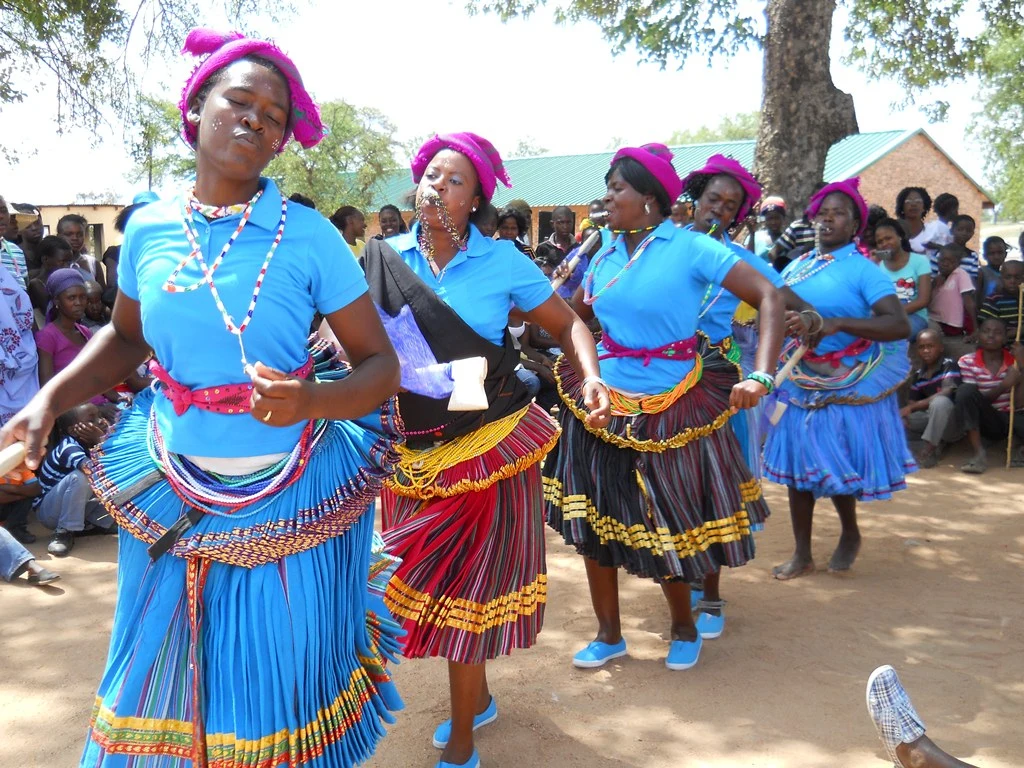Exploring the Venda, Ndebele, and Tsonga People of South Africa
The Venda people are a Bantu ethnic group native to Southern Africa, particularly in the northern parts of South Africa, Zimbabwe, and Botswana. Here are key points about the Venda people:
- Geographical Distribution:
- The Venda people are primarily found in the northern part of South Africa, particularly in the Limpopo Province. They also have a presence in neighboring regions of Zimbabwe and Botswana.
- Language:
- The Venda people speak Tshivenda, a Bantu language that is characterized by its distinct linguistic features. Tshivenda is one of South Africa’s official languages.
- Cultural Identity:
- Venda culture is rich and diverse, encompassing various aspects of life such as music, dance, art, and spiritual beliefs. Traditional Venda music is known for its unique instruments and vocal styles.
- Social Structure:
- Venda society traditionally had a hierarchical social structure with chiefs and a royal family playing prominent roles. Clans and extended families formed the core social units, and respect for elders was emphasized.
- Economic Activities:
- Historically, the Venda people were engaged in agriculture, cultivating crops such as maize, millet, and sorghum. Livestock farming, particularly cattle, was also an essential part of their economy.
- Spirituality and Religion:
- The Venda people have a strong connection to their spiritual beliefs. Traditional Venda religion involves the worship of a supreme being and the veneration of ancestors. Rituals and ceremonies are conducted to honor and communicate with the spiritual realm.
- Art and Craftsmanship:
- Venda art is characterized by its vibrant colors and intricate designs. Pottery, beadwork, and woodcarving are traditional forms of artistic expression. The famous woodcarvers of the Venda are known for their skill in creating sculptures and functional items.
- Thohoyandou:
- Thohoyandou, located in the Limpopo Province, is the capital of the Venda people. It serves as a cultural and economic center for the community.
- Historical Kingdom:
- The Venda people have a history of organized states and kingdoms. The Venda Kingdom, led by a king or chief, played a role in shaping the political and cultural landscape of the region.
- Contemporary Challenges:
- Like many other ethnic groups, the Venda people face contemporary challenges such as socio-economic disparities, urbanization, and the preservation of cultural practices in the modern context.
The Venda people, with their unique cultural heritage and contributions to the history of Southern Africa, continue to be an important part of the region’s diverse ethnic groups.
Explore the Ancestral Origins of the Ndebele People of South Africa
The Ndebele people of South Africa are a distinct ethnic group known for their rich cultural heritage, vibrant art, and intricate beadwork. Originating from the Bantu-speaking Nguni tribes, the Ndebele are primarily found in the Mpumalanga and Limpopo provinces. They are divided into two main groups: the Southern Ndebele and the Northern Ndebele, each with unique dialects and cultural practices.
One of the most striking aspects of Ndebele culture is their colorful and geometrically patterned house paintings and beadwork. These art forms are not only decorative but also serve as expressions of identity and social status. Traditionally, Ndebele women are the primary artisans, passing down their skills through generations.
Historically, the Ndebele people faced numerous challenges, including conflicts with other tribes and colonial forces. Despite these adversities, they have maintained their cultural practices and continue to celebrate their heritage through festivals, traditional ceremonies, and by preserving their language and artistic traditions.
Ndebele People:
Ancestral Origins:
- Musi and his followers settled in the Transvaal at the site of modern Pretoria. The descendants of Musi’s people were later joined in the 18th and 19th centuries by Nguni people fleeing from the wars of Dingiswayo and Shaka in Natal.
- Geographical Distribution:
- The Ndebele people are found in Southern Africa, primarily in Zimbabwe and South Africa. There are two main groups: the Northern Ndebele (in Zimbabwe) and the Southern Ndebele (in South Africa).
- Language:
- The Ndebele people speak isiNdebele, a Bantu language. The language is characterized by its distinct linguistic features and expressions.
- Culture and Art:
- Ndebele culture is rich in artistic expression, particularly known for its vibrant and colorful beadwork, wall paintings, and murals. Ndebele women, in particular, are renowned for their skill in creating intricate beadwork patterns.
- Social Structure:
- Traditionally, Ndebele society is organized around clans, and family ties play a crucial role. The extended family is an important social unit, and the respect for elders is emphasized.

- Economic Activities:
- Historically, the Ndebele people were cattle herders and farmers. Agriculture, particularly the cultivation of crops like maize, sorghum, and pumpkins, has been a significant part of their economy.
- History and Migration:
- Migration History:
- The Ndebele are ancient offshoots of the main Nguni-speaking peoples. In the 17th century, they began migrations to the Transvaal region. The main group of Transvaal Ndebele can trace their ancestry to Musi (or Msi), who, along with his followers, diverged from a small group of Nguni people migrating down the southeastern coast of Africa.
- Ceremonies and Rituals:
- Ndebele cultural practices include various ceremonies and rituals. Coming-of-age ceremonies, marriage ceremonies, and rituals related to ancestors are important cultural events.
- Religion:
- Traditional Ndebele religion involves the worship of ancestors, who are believed to play a role in the lives of the living. Ancestral spirits are often consulted and honored through rituals.
- Contemporary Challenges:
- Like many African communities, the Ndebele people face contemporary challenges such as socio-economic disparities, urbanization, and the preservation of cultural practices in the modern context.

- Political History:
- In Zimbabwe, the Ndebele people have played a significant role in the country’s history, especially during the pre-colonial and colonial eras. The Matabele Kingdom, established by Mzilikazi, had a complex relationship with British colonial forces.
The Ndebele people, with their unique cultural heritage and contributions to the history of Southern Africa, continue to be an important part of the region’s diverse tapestry.
Explore the Culture of The Tsonga people of South Africa
The Tsonga people, also known as the Shangaan, are a Bantu ethnic group native to Southern Africa. Here are some key points about the Tsonga people:
- Geographical Distribution:
- The Tsonga people are primarily found in southern Mozambique, southeastern Zimbabwe, Swaziland, and the Limpopo Province of South Africa. They have a presence in the lowveld areas of these regions.
- Language:
- The Tsonga people speak Xitsonga, a Bantu language that is part of the larger Niger-Congo language family. Xitsonga has various dialects and is recognized as one of South Africa’s official languages.

- Cultural Identity:
- Tsonga cultural identity is characterized by traditional practices, music, dance, and art. The vibrant and rhythmic traditional music and dance forms an integral part of Tsonga cultural celebrations and ceremonies.
- Traditional Dress:
- Traditional Tsonga attire includes colorful and intricately designed clothing. Beadwork is often used to adorn clothing, and garments are complemented by accessories such as beadwork jewelry and headgear.
- Economic Activities:
- Historically, the Tsonga people have been engaged in agriculture, cultivating crops such as maize, millet, and sorghum. Livestock farming, particularly cattle and goats, is also part of their traditional economy.
- Social Structure:
- Tsonga society traditionally had a clan-based social structure. Clan identities were important, and marriages often occurred within specific clans. The social structure also involved age sets, with individuals progressing through different stages of life.
- Migration and Displacement:
- Over the years, the Tsonga people, particularly the Shangaan subgroup, have experienced historical migration and displacement. The Shangaan people, for example, originated from the Gaza Kingdom and migrated southwards, establishing the Gaza Empire in parts of present-day South Africa and Mozambique.

- Religion:
- The traditional Tsonga belief system includes a reverence for ancestors. Ancestors are considered to play a significant role in the lives of the living, and ceremonies are conducted to honor and communicate with them.
- Contemporary Challenges:
- Like many other ethnic groups, the Tsonga people face contemporary challenges such as socio-economic disparities, cultural preservation in the face of modernization, and issues related to land and resource access.
- Cultural Festivals:
- The Tsonga people celebrate various cultural festivals, including the Xitsonga New Year, which is marked with traditional dances, music, and rituals.

The Tsonga people, with their rich cultural heritage and traditions, contribute to the diversity of Southern Africa’s ethnic tapestry. The various subgroups within the Tsonga, such as the Shangaan, add further nuances to their collective identity.
